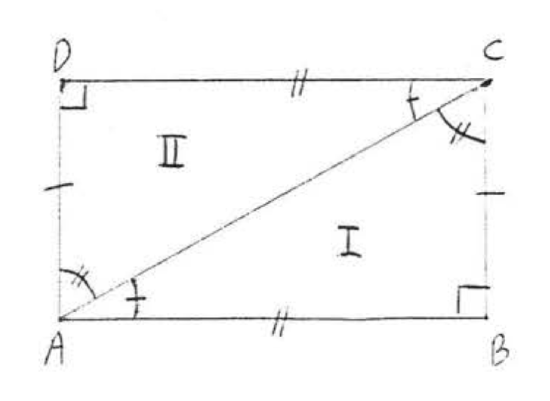2.1: The Congruence Statement
- Page ID
- 34124
\( \newcommand{\vecs}[1]{\overset { \scriptstyle \rightharpoonup} {\mathbf{#1}} } \)
\( \newcommand{\vecd}[1]{\overset{-\!-\!\rightharpoonup}{\vphantom{a}\smash {#1}}} \)
\( \newcommand{\dsum}{\displaystyle\sum\limits} \)
\( \newcommand{\dint}{\displaystyle\int\limits} \)
\( \newcommand{\dlim}{\displaystyle\lim\limits} \)
\( \newcommand{\id}{\mathrm{id}}\) \( \newcommand{\Span}{\mathrm{span}}\)
( \newcommand{\kernel}{\mathrm{null}\,}\) \( \newcommand{\range}{\mathrm{range}\,}\)
\( \newcommand{\RealPart}{\mathrm{Re}}\) \( \newcommand{\ImaginaryPart}{\mathrm{Im}}\)
\( \newcommand{\Argument}{\mathrm{Arg}}\) \( \newcommand{\norm}[1]{\| #1 \|}\)
\( \newcommand{\inner}[2]{\langle #1, #2 \rangle}\)
\( \newcommand{\Span}{\mathrm{span}}\)
\( \newcommand{\id}{\mathrm{id}}\)
\( \newcommand{\Span}{\mathrm{span}}\)
\( \newcommand{\kernel}{\mathrm{null}\,}\)
\( \newcommand{\range}{\mathrm{range}\,}\)
\( \newcommand{\RealPart}{\mathrm{Re}}\)
\( \newcommand{\ImaginaryPart}{\mathrm{Im}}\)
\( \newcommand{\Argument}{\mathrm{Arg}}\)
\( \newcommand{\norm}[1]{\| #1 \|}\)
\( \newcommand{\inner}[2]{\langle #1, #2 \rangle}\)
\( \newcommand{\Span}{\mathrm{span}}\) \( \newcommand{\AA}{\unicode[.8,0]{x212B}}\)
\( \newcommand{\vectorA}[1]{\vec{#1}} % arrow\)
\( \newcommand{\vectorAt}[1]{\vec{\text{#1}}} % arrow\)
\( \newcommand{\vectorB}[1]{\overset { \scriptstyle \rightharpoonup} {\mathbf{#1}} } \)
\( \newcommand{\vectorC}[1]{\textbf{#1}} \)
\( \newcommand{\vectorD}[1]{\overrightarrow{#1}} \)
\( \newcommand{\vectorDt}[1]{\overrightarrow{\text{#1}}} \)
\( \newcommand{\vectE}[1]{\overset{-\!-\!\rightharpoonup}{\vphantom{a}\smash{\mathbf {#1}}}} \)
\( \newcommand{\vecs}[1]{\overset { \scriptstyle \rightharpoonup} {\mathbf{#1}} } \)
\( \newcommand{\vecd}[1]{\overset{-\!-\!\rightharpoonup}{\vphantom{a}\smash {#1}}} \)
\(\newcommand{\avec}{\mathbf a}\) \(\newcommand{\bvec}{\mathbf b}\) \(\newcommand{\cvec}{\mathbf c}\) \(\newcommand{\dvec}{\mathbf d}\) \(\newcommand{\dtil}{\widetilde{\mathbf d}}\) \(\newcommand{\evec}{\mathbf e}\) \(\newcommand{\fvec}{\mathbf f}\) \(\newcommand{\nvec}{\mathbf n}\) \(\newcommand{\pvec}{\mathbf p}\) \(\newcommand{\qvec}{\mathbf q}\) \(\newcommand{\svec}{\mathbf s}\) \(\newcommand{\tvec}{\mathbf t}\) \(\newcommand{\uvec}{\mathbf u}\) \(\newcommand{\vvec}{\mathbf v}\) \(\newcommand{\wvec}{\mathbf w}\) \(\newcommand{\xvec}{\mathbf x}\) \(\newcommand{\yvec}{\mathbf y}\) \(\newcommand{\zvec}{\mathbf z}\) \(\newcommand{\rvec}{\mathbf r}\) \(\newcommand{\mvec}{\mathbf m}\) \(\newcommand{\zerovec}{\mathbf 0}\) \(\newcommand{\onevec}{\mathbf 1}\) \(\newcommand{\real}{\mathbb R}\) \(\newcommand{\twovec}[2]{\left[\begin{array}{r}#1 \\ #2 \end{array}\right]}\) \(\newcommand{\ctwovec}[2]{\left[\begin{array}{c}#1 \\ #2 \end{array}\right]}\) \(\newcommand{\threevec}[3]{\left[\begin{array}{r}#1 \\ #2 \\ #3 \end{array}\right]}\) \(\newcommand{\cthreevec}[3]{\left[\begin{array}{c}#1 \\ #2 \\ #3 \end{array}\right]}\) \(\newcommand{\fourvec}[4]{\left[\begin{array}{r}#1 \\ #2 \\ #3 \\ #4 \end{array}\right]}\) \(\newcommand{\cfourvec}[4]{\left[\begin{array}{c}#1 \\ #2 \\ #3 \\ #4 \end{array}\right]}\) \(\newcommand{\fivevec}[5]{\left[\begin{array}{r}#1 \\ #2 \\ #3 \\ #4 \\ #5 \\ \end{array}\right]}\) \(\newcommand{\cfivevec}[5]{\left[\begin{array}{c}#1 \\ #2 \\ #3 \\ #4 \\ #5 \\ \end{array}\right]}\) \(\newcommand{\mattwo}[4]{\left[\begin{array}{rr}#1 \amp #2 \\ #3 \amp #4 \\ \end{array}\right]}\) \(\newcommand{\laspan}[1]{\text{Span}\{#1\}}\) \(\newcommand{\bcal}{\cal B}\) \(\newcommand{\ccal}{\cal C}\) \(\newcommand{\scal}{\cal S}\) \(\newcommand{\wcal}{\cal W}\) \(\newcommand{\ecal}{\cal E}\) \(\newcommand{\coords}[2]{\left\{#1\right\}_{#2}}\) \(\newcommand{\gray}[1]{\color{gray}{#1}}\) \(\newcommand{\lgray}[1]{\color{lightgray}{#1}}\) \(\newcommand{\rank}{\operatorname{rank}}\) \(\newcommand{\row}{\text{Row}}\) \(\newcommand{\col}{\text{Col}}\) \(\renewcommand{\row}{\text{Row}}\) \(\newcommand{\nul}{\text{Nul}}\) \(\newcommand{\var}{\text{Var}}\) \(\newcommand{\corr}{\text{corr}}\) \(\newcommand{\len}[1]{\left|#1\right|}\) \(\newcommand{\bbar}{\overline{\bvec}}\) \(\newcommand{\bhat}{\widehat{\bvec}}\) \(\newcommand{\bperp}{\bvec^\perp}\) \(\newcommand{\xhat}{\widehat{\xvec}}\) \(\newcommand{\vhat}{\widehat{\vvec}}\) \(\newcommand{\uhat}{\widehat{\uvec}}\) \(\newcommand{\what}{\widehat{\wvec}}\) \(\newcommand{\Sighat}{\widehat{\Sigma}}\) \(\newcommand{\lt}{<}\) \(\newcommand{\gt}{>}\) \(\newcommand{\amp}{&}\) \(\definecolor{fillinmathshade}{gray}{0.9}\)Two triangles are said to be congruent if one can be placed over the other so that they coincide (fit together). This means that congruent triangles are exact copies of each other and when fitted together the sides and angles which coincide, called corresponding sides and angles, are equal.
In Figure \(\PageIndex{1}\), \(\triangle ABC\) is congruent to \(\triangle DEF\). The symbol for congruence is \(\cong\) and we write \(\triangle ABC \cong \triangle DEF\). \(\angle A\) corresponds to \(\angle D\), \(\angle B\) corresponds to \(\angle E\), and \(\angle C\) corresponds to \(\angle F\). Side \(AB\) corresponds to \(DE, BC\) corresponds to \(EF\), and \(AC\) corresponds to \(DF\).

In this book the congruence statement \(\triangle ABC \cong \triangle DEF\) will always be written so that corresponding vertices appear in the same order, For the triangles in Figure \(\PageIndex{1}\), we might also write \(\triangle BAC \cong \triangle EDF\) or \(\triangle ACB \cong \triangle DFE\) but never for example \(\triangle ABC \cong \triangle EDF\) nor \(\triangle ACB \cong \triangle DEF\). (Be warned that not all textbooks follow this practice, Many authors wil write the letters without regard to the order. If that is the case then we cannot tell which parts correspond from the congruence statement)
Therefore we can always tell which parts correspond just from the congruence statement. For example, given that \(\triangle ABC \cong \triangle DEF\), side \(AB\) corresponds to side \(DE\) because each consists of the first two letters, \(AC\) corresponds to DF because each consists of the first and last letters, \(BC\) corresponds to \(EF\) because each consists of the last two letters.
If \(\triangle PQR \cong \triangle STR\)
- list the corresponding angles and sides;
- find \(x\) and \(y\).
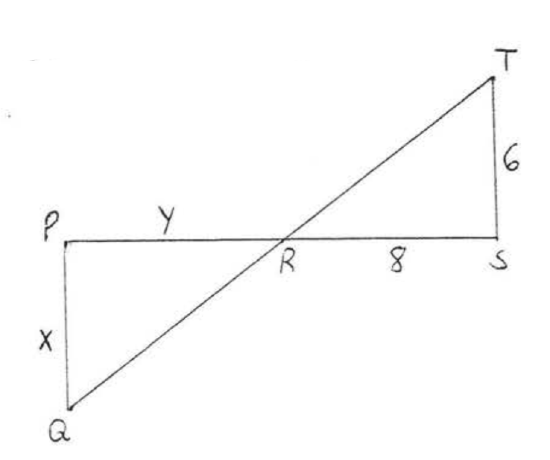
Solution
(1)
\(\begin{array} {rcll} {\underline{\triangle PQR}} & \ & {\underline{\triangle STR}} & {} \\ {\angle P} & = & {\angle S} & {\text{(first letter of each triangle in congruence statement)}} \\ {\angle Q} & = & {\angle T} & {\text{(second letter)}} \\ {\angle PRQ} & = & {\angle SRT} & {\text{(third letter. We don't write "}\angle R = \angle R \text{" since}} \\ {} & & {} & {\text{each }\angle R \text{ is different)}} \\ {PQ} & = & {ST} & {\text{(first two letters)}} \\ {PR} & = & {SR} & {\text{(firsst and last letters)}} \\ {QR} & = & {TR} & {\text{(last two letters)}} \end{array}\)
(2)
\(x = PQ = ST = 6\).
\(y = PR = SR = 8\).
Answer (2): \(x = 6, y = 8\).
Assuming \(\triangle I \cong \triangle II\), write a congruence statement for \(\triangle I\) and \(\triangle II\):
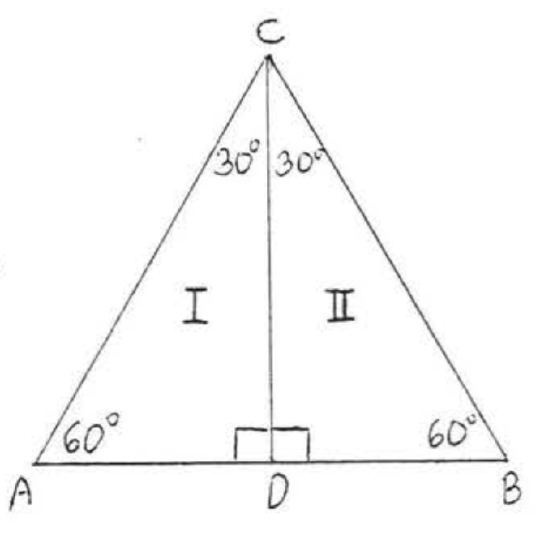
Solution
\(\begin{array} {rcll} {\triangle I} & \ & {\triangle II} & {} \\ {\angle A} & = & {\angle B} & {(\text{both = } 60^{\circ})} \\ {\angle ACD} & = & {\angle BCD} & {(\text{both = } 30^{\circ})} \\ {\angle ADC} & = & {\angle BDC} & {(\text{both = } 90^{\circ})} \end{array}\)
Therefore 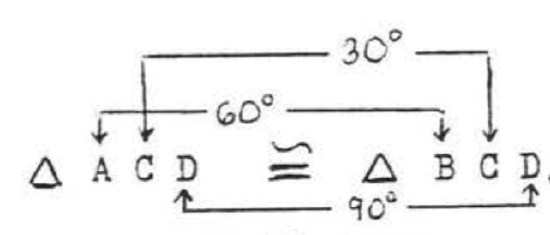
Answer: \(\triangle ACD \cong \triangle BCD\).
Assuming \(\triangle I \cong \triangle II\), write a congruence statement for \(\triangle I\) and \(\triangle II\):
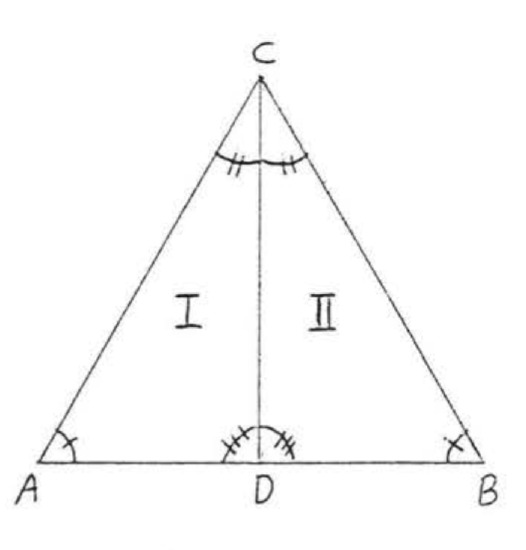
Solution
The angles that are marked the same way are assumed to be equal.
\(\begin{array} {rcll} {\underline{\triangle I}} & \ & {\underline{\triangle II}} & {} \\ {\angle A} & = & {\angle B} & {(\text{both marked with one stroke})} \\ {\angle ACD} & = & {\angle BCD} & {(\text{both marked with two strokes})} \\ {\angle ADC} & = & {\angle BDC} & {(\text{both marked with three strokes})} \end{array}\)
The relationships are the same as in Example \(\PageIndex{2}\).
Answer: \(\triangle ACD \cong \triangle BCD\).
Problems
1 - 4. For each pair of congruent triangles
(1) list the corresponding sides and angles;
(2) find \(x\) and \(y\).
1. \(\triangle ABC \cong \triangle DEF\).

2. \(\triangle PQR \cong \triangle STU\).
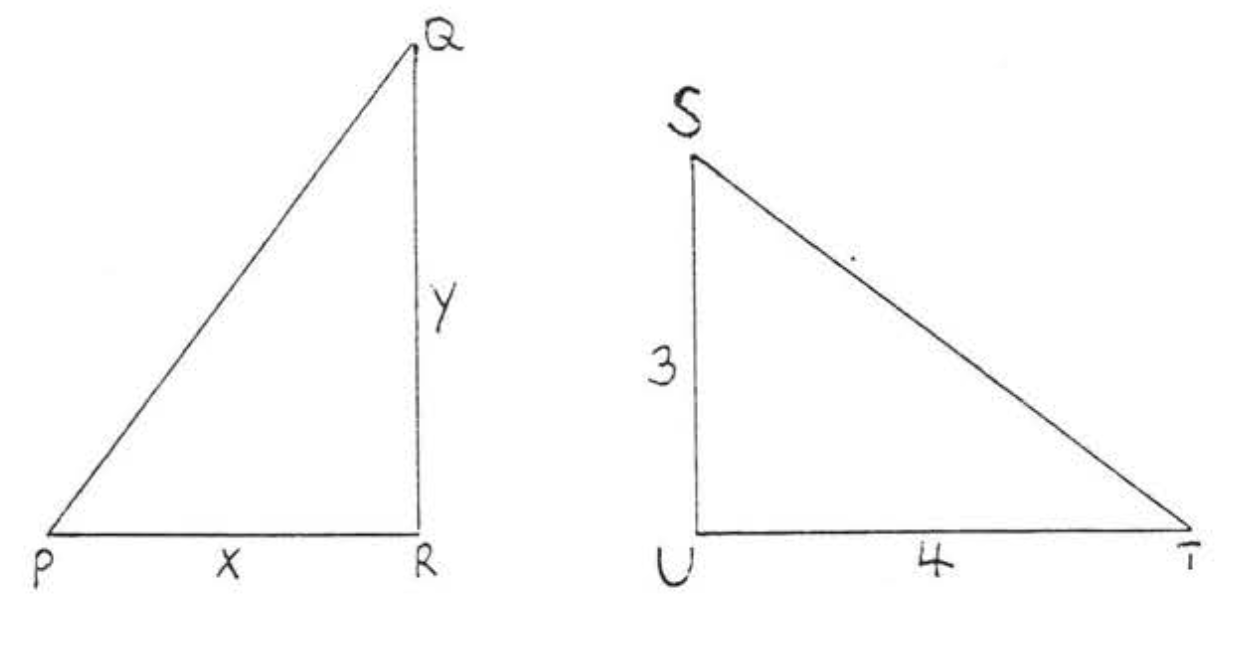
3. \(\triangle ABC \cong \triangle CDA\).
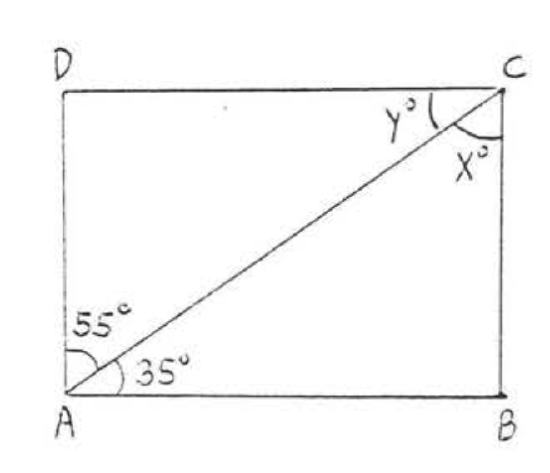
4. \(\triangle ABC \cong \triangle EDC\).
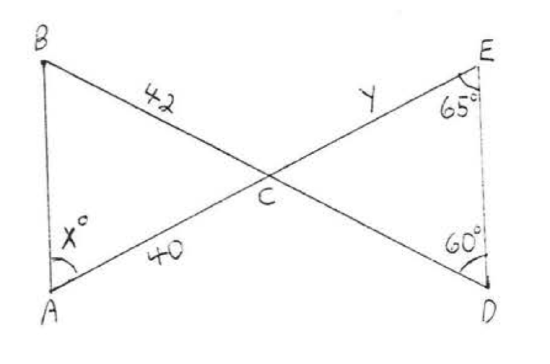
5 - 10. Write a congruence statement for each of the following. Assume the triangles are congruent and that angles or sides marked in the same way are equal.
5. 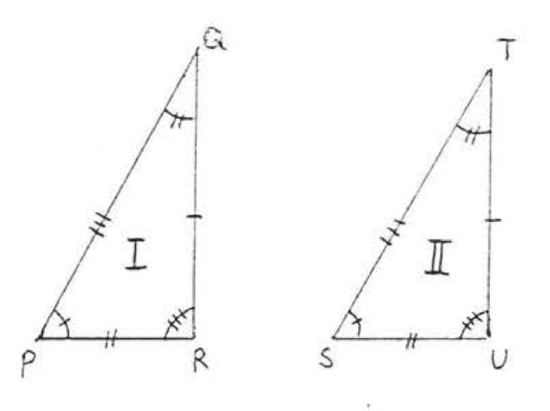 6.
6. 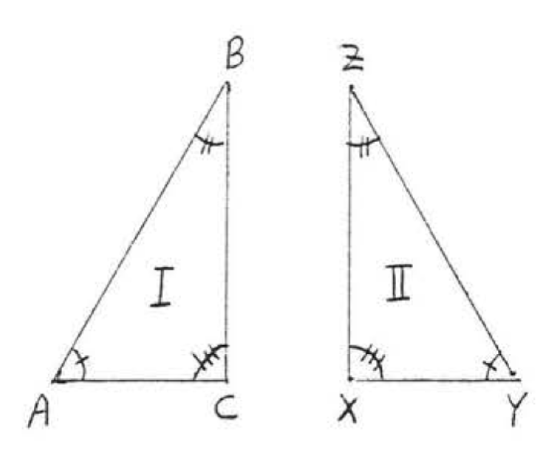
7. 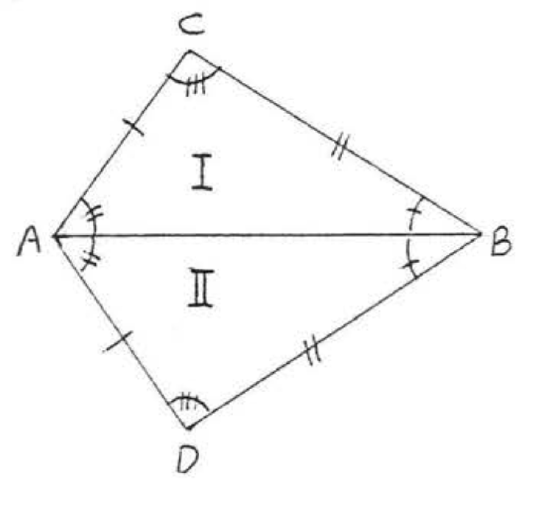 8.
8. 
9. 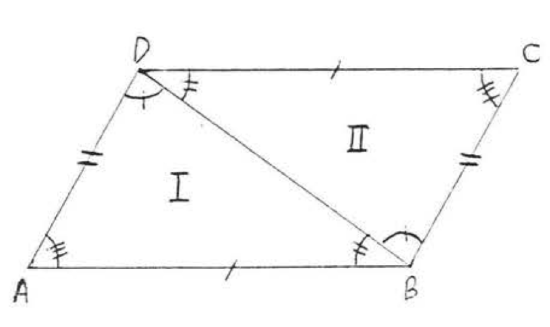 10.
10. 